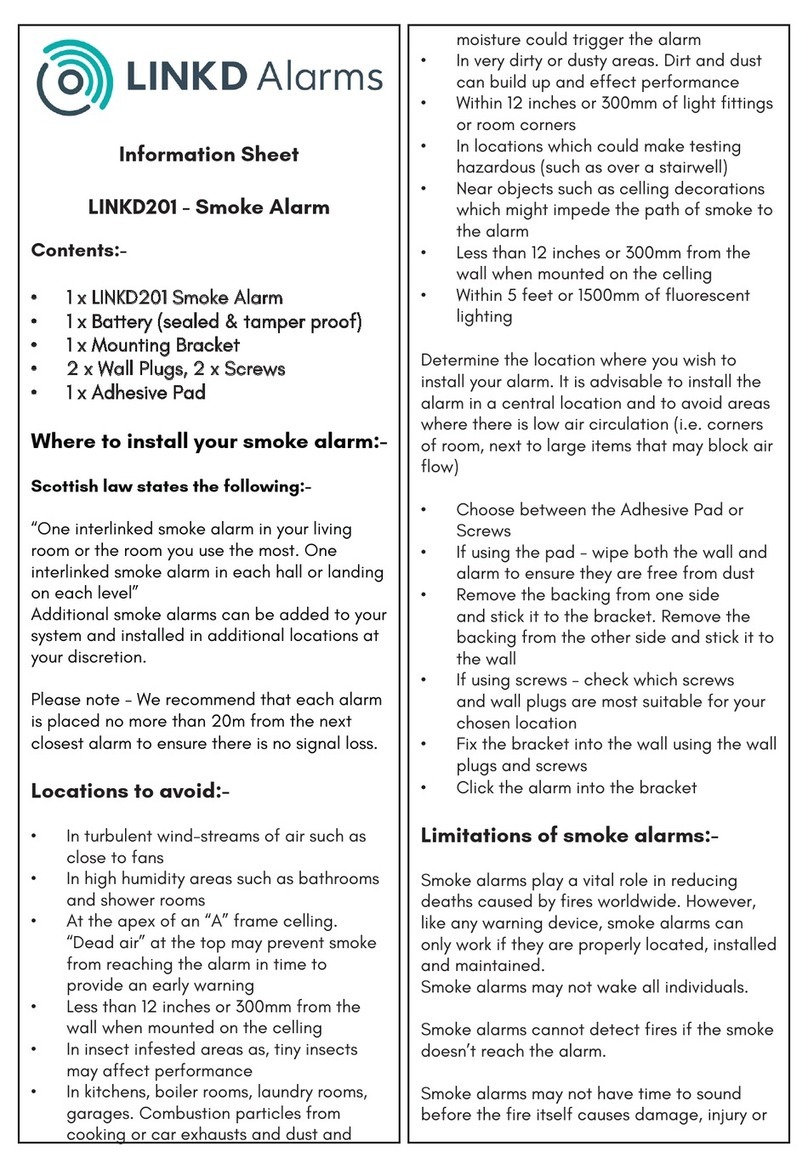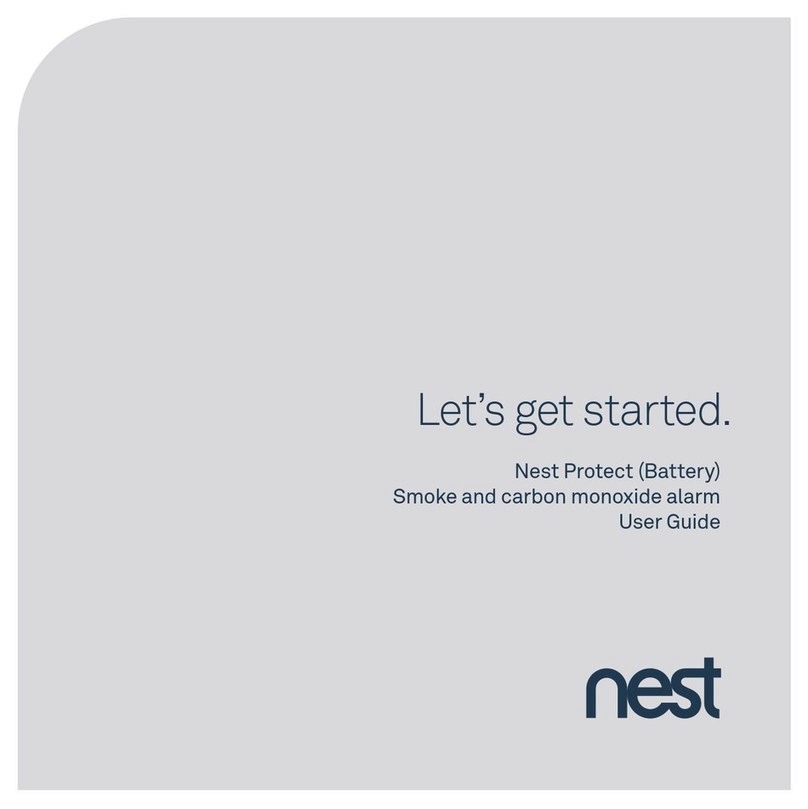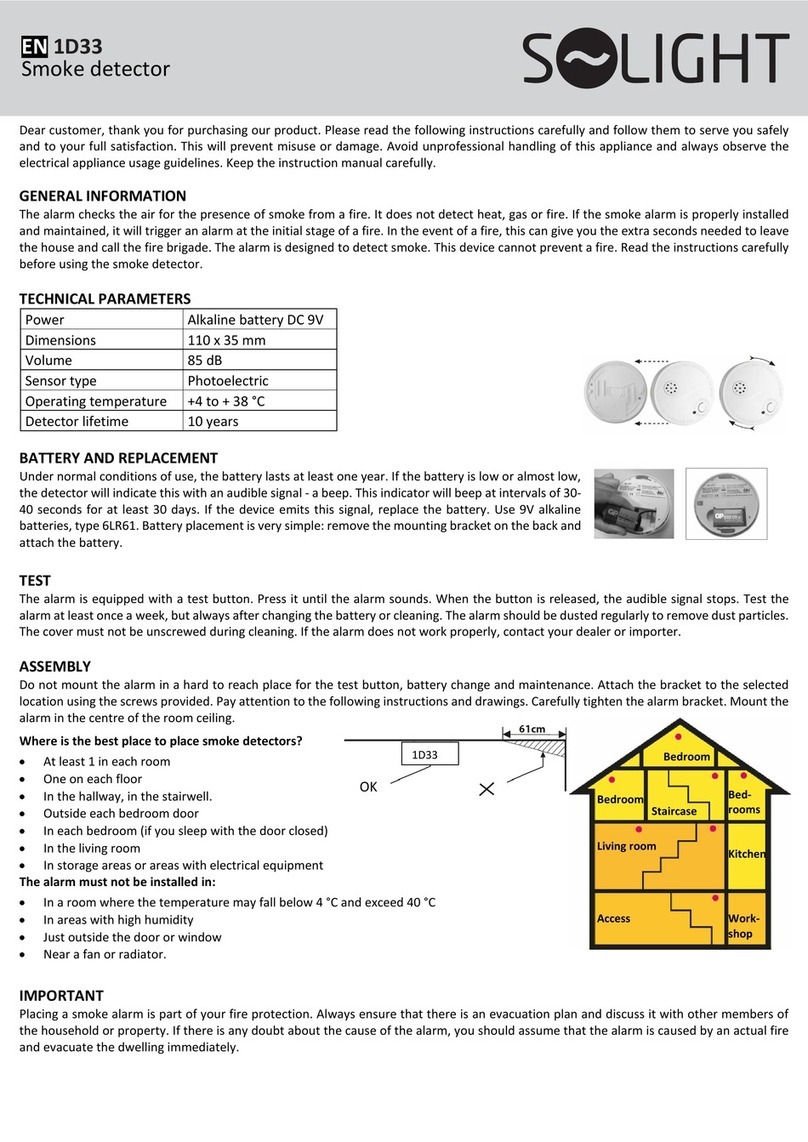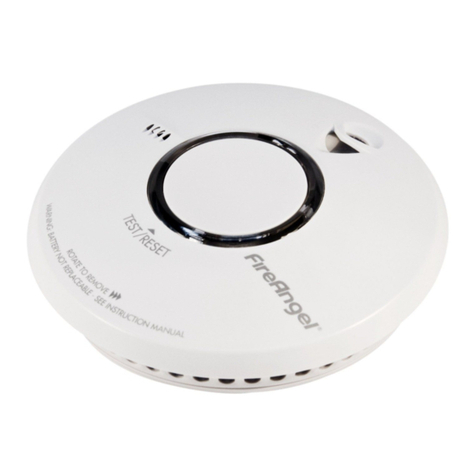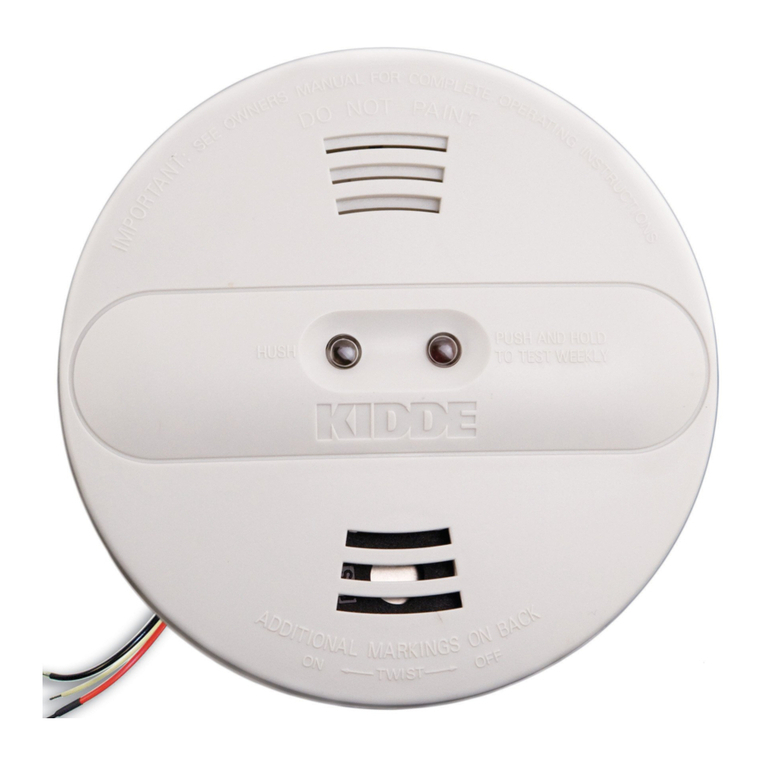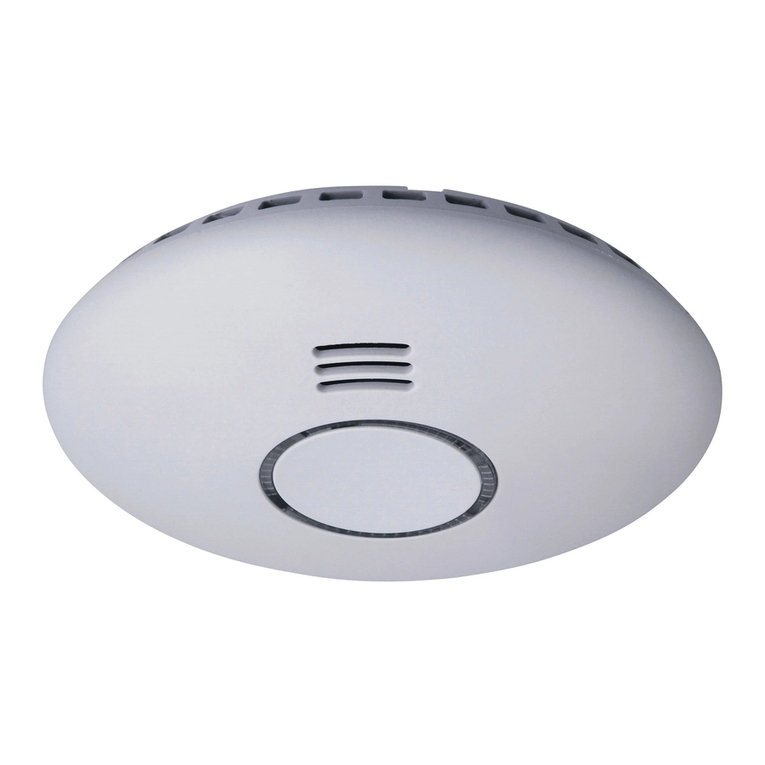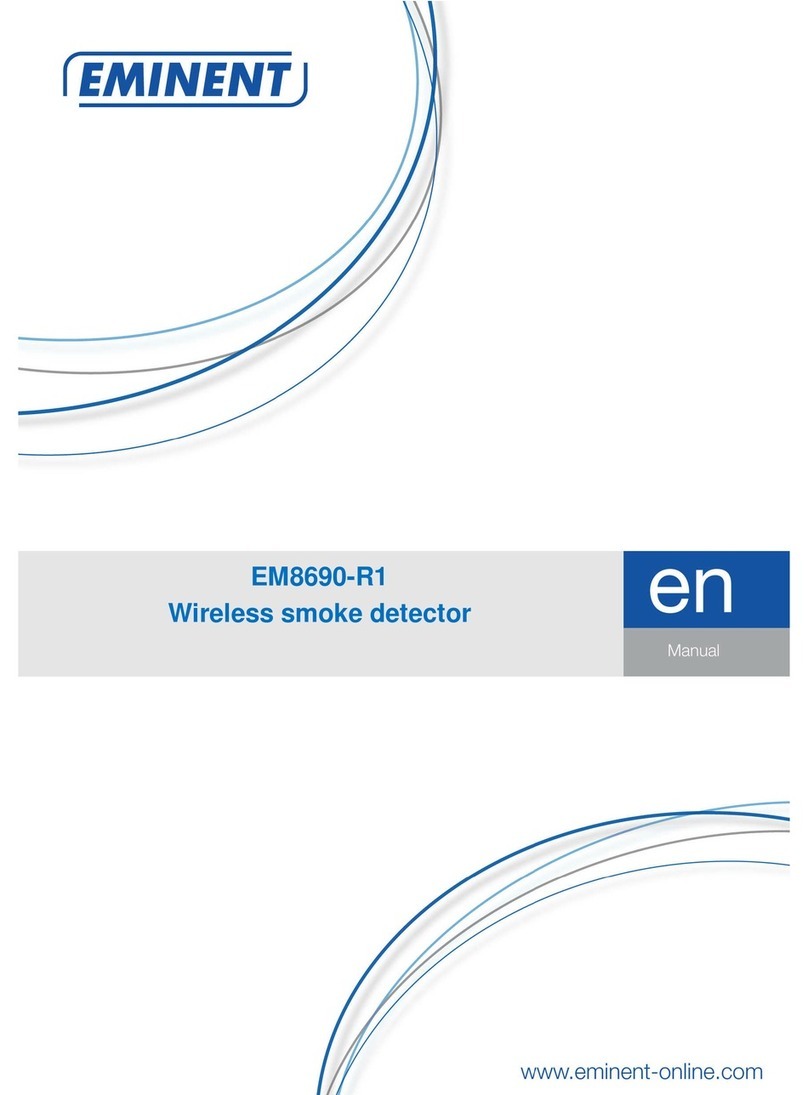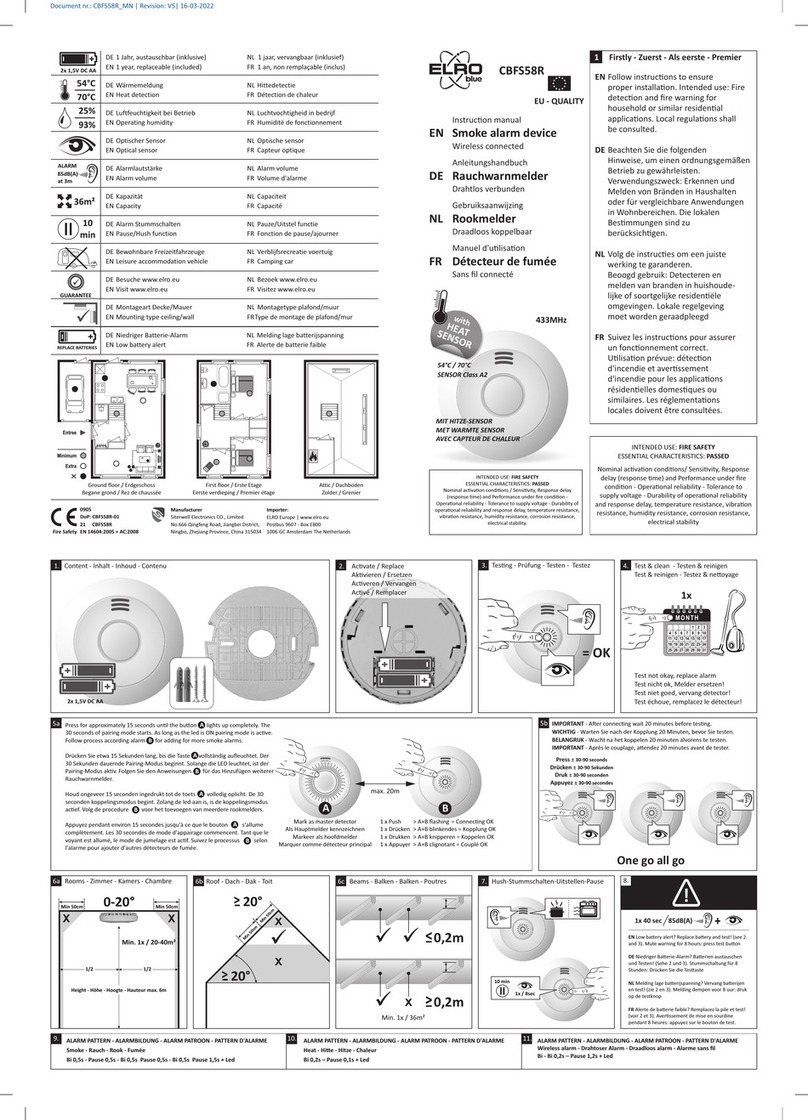Innotek Protek Wireless IW-101A User manual

USER’S MANUAL IW-101A
PROTEK WIRELESS™
IMPORTANT!
PLEASE READ CAREFULLY AND SAVE.
This user’s manual contains important information about your Smoke Alarm’s
operation. If you are installing this Smoke Alarm for use by others, you must
leave this manual – or a copy of it – with the end user.
FIRE SAFETY TIPS
Follow safety rules and prevent hazardous situations: 1) Use smoking
materials property. Never smoke in bed 2) Keep matches or lighters away from
children; 3) Store flammable materials in proper containers; 4) Keep electrical
appliances in good condition and don’t overload electrical circuits; 5) Keep
stoves, barbecue grills, fireplaces and chimneys grease- and debris-free; 6)
Never leave anything cooking on the stove unattended; 7) Keep portable
heaters and open flames, like candles, away from flammable materials; 8)
Don’t let rubbish accumulate.
Keep alarms clean, and test them weekly. Replace alarms immediately if they
are not working properly. Smoke Alarms that do not work cannot alert you to a
fire. Keep at least one working fire extinguisher on every floor, and an
additional one in the kitchen. Have fire escape ladders or other reliable means
of escape from an upper floor in case stairs are blocked.
BEFORE YOU INSTALL THIS SMOKE ALARM
Important! Read “Recommended Locations for Smoke Alarms” and “Locations
to Avoid for Smoke Alarms” before beginning. This unit monitors the air, and
when smoke reaches its sensing chamber, it alarms. It can give you more time
to escape before fire spreads. This unit can ONLY give an early warning of
developing fires if it is installed, maintained and located where smoke can
reach it, and where all residents can hear it, as described in this manual. This
unit will not sense gas, heat, or flame. It cannot prevent or extinguish fires.
Understand The Different Type of Smoke Alarms
Battery powered electrical? Different Smoke Alarms provide different types of
protection. See “About Smoke Alarms” for details.
Know Where to Install Your Smoke Alarms
Fire Safety Professionals recommend at least one Smoke Alarm on every level
of your home, in every bedroom, and in every bedroom hallway or separate
sleeping area. See “Recommended Locations for Smoke Alarms” and
“Locations to Avoid for Smoke Alarms” for details.
Know What Smoke Alarms Can and Can’t Do
A Smoke Alarm can help alert you to fire, giving you precious time to escape. It
can only sound an alarm once smoke reaches the sensor. See “Limitations of
Smoke Alarms” for details.
Check Your Local Building Codes
This Smoke Alarm is designed to be used in a typical single-family home. It
alone will not meet requirements for boarding houses, apartment buildings,
hotels or motels. See “Special Compliance Considerations” for details.
WARNING!
This unit will not alert hearing impaired residents. It is recommended that you
install special units which use devices like flashing strobe lights to alert
hearing impaired residents.
Do not connect this unit to any other alarm or auxiliary device. It is a single-
station unit that cannot be linked to other devices. Connecting anything else
to this unit may prevent it from working properly.
Unit will not operate without battery power. The Smoke Alarm cannot work
until you install the batteries in the correct position (Match “+“to “+“and “-“to “-
“).
CAUTION!
Do not install this unit over an electrical junction box. Air currents around
junction boxes can prevent smoke from reaching the sensing chanter and
prevent the unit from alarming. Only AC powered units are intended for
installation over junction boxes.
Do not stand too close to the unit when the alarm is sounding. It is loud to
wake you in an emergency. Exposure to the horn at close range may harm
your hearing.
*
*Document ID # IW101A-M2
RECOMMENDED LOCATIONS FOR SMOKE ALARMS
Installing Smoke Alarms in Single-Family Residences
The National Fire Protection Association (NFPA), recommends one Smoke
Alarm on every floor, in every sleeping area, and in every bedroom. See
“Agency Placement Recommendations” for details. For additional coverage, it
is recommended that you install a Smoke Alarm in rooms, halls, storage areas,
finished attics, and basements, where temperatures normally remain between
40° F (4° C) and 100° F (38° C). Make sure no door or other obstruction could
keep smoke from reaching the Smoke Alarms.
More specifically install Smoke Alarms:
On every level of your home, including finished attics and basements.
Inside every bedroom, especially if people sleep with doors closed
In the hall near every sleeping area. If your home has multiple sleeping
areas, install a unit in each. If a hall is over 40 feet (12 meters) long, install
an alarm at each end
At the top of the first-to-second floor stairway and at bottom of basement
stairway
IMPORTANT!
Specific requirements for Smoke Alarm installation vary from state to state and
from region to region. Check with your local Fire Department for current
requirements in your area. It is recommended for units to be
interconnected for added protection.
IMPORTANT!
This equipment should be installed in accordance with NFPA (National Fire
Protection Association) 72 and 101. National Fire Protection Association, One
Batterymarch Park, Quincy, MA 02269-9101. Additional local building and
regulatory codes may apply in your area. Always check compliance
requirements before beginning any installation. This model is not R.V.
listed with Underwriters Laboratories Inc.
AGENCY PLACEMENT RECOMMENDATIONS
NFPA 72 (National Fire Code)
Smoke Alarms shall be installed in each separate sleeping room, outside each
sleeping area in the immediate vicinity of the bedrooms and on each additional
story of the family living unit, including basements and excluding crawl spaces
and unfinished attics.
In new construction, Alarms shall be so arranged that operation of any one
Alarm shall cause the operation of all Alarms within the dwelling.
Smoke Detection-Are More Smoke Alarms Desirable? The required
number of Smoke Alarms might not provide reliable early warning protection
for those areas separated by a door from the areas protected by the required
Smoke Alarms. For this reason, it is recommended that the householder
consider the use of additional Smoke Alarms for those areas for increased
protection. The additional areas include the basement, bedrooms, dining room,
furnace room, utility room, and hallways not protected by the required Smoke
Alarms. The installation of Smoke Alarms in kitchens, attics (finished or
unfinished), or garages is not normally recommended, as these locations
occasionally experience conditions that can result in improper operation.
*All PROTEKWIRELESS™Alarms conform to regulatory requirements
including UL217 and are designed to detect particles of combustion.
Smoke particles of varying number and size are produced in all fires.
Ionization technology is generally more sensitive than photoelectric
technology at detecting small particles, which tend to be produced in
greater amounts by flaming fires, which consume combustible
materials rapidly and spread quickly Sources of these fires, may include paper
burning in a wastebasket, or a grease fire in the kitchen.
Photoelectric technology is generally more sensitive than ionization
technology at detecting large particles, which tend to be produced in
greater amounts by smoldering fires, which may smolder for hours
before bursting into flame. Sources of these fires may include cigarettes
burning in couches or bedding.

LOCATIONS TO AVOID FOR SMOKE ALARMS
For best performance, it is recommended you AVOID installing
Smoke Alarms in these areas:
Where combustion particles are produced Combustion particles form
something burns. Areas to avoid include poorly ventilated kitchens, garages,
and furnace rooms. Keep units at least 20 feet (6 meters) from the sources of
combustion particles (stove, furnace, water heater, space heater) if possible.
In areas where a 20-foot (6-meter) distance is not possible — in modular,
mobile, or smaller homes, for example - it is recommended the Smoke Alarm
be placed as far from these fuel-burning sources as possible. The placement
recommendations are intended to keep these Alarms at a reasonable
distance from a fuel-burning source, and thus reduce “unwanted” alarms.
Unwanted alarms can occur if a Smoke Alarm is placed directly next to a
fuel-burning source. Ventilate these areas as much as possible.
In air streams near kitchens. Air currents can draw cooking smoke into the
sensing chamber of a Smoke Alarm near the kitchen.
In very damp, humid or steamy areas, or directly near bathrooms with
showers. Keep units at least 10 feet (3 meters) away from showers, saunas,
dishwashers, etc.
Where the temperatures are regularly below 40° F (4° C) or above 100° F
(38° C), including unheated buildings, outdoor rooms, porches, or unfinished
attics or basements.
In very dusty dirty, or greasy areas. Do not install a Smoke Alarm directly
over the stove or range. Keep laundry room Smoke Alarms free of dust or
lint.
Near fresh air vents, ceiling fans, or in very drafty areas. Drafts can blow
smoke away from the unit, preventing it from reaching the sensing chamber.
In insect infested areas. Insects can clog openings to the sensing chamber
and cause unwanted alarms.
Less than 12 inches (305mm) away from fluorescent lights. Electrical “noise”
can interfere with the sensor.
In “dead air” spaces. “Dead air” spaces may prevent smoke from reaching
the Smoke Alarm
Avoiding Dead Air Spaces
“Dead air” spaces may prevent smoke from reaching the Smoke Alarm. To
avoid dead air spaces, follow the installation recommendations below.
On ceilings, install Smoke Alarms as close to the center of the ceiling as
possible. If this is not possible, install the Smoke Alarm at least 4 inches (102
mm) from the wall or corners.
For wall mounting (if allowed by building codes), the top edge of Smoke
Alarms should be placed between 4 and 12 inches (102 and 305 mm) from the
wail/ceiling line, below typical “dead air” spaces.
On a peaked, gabled, or cathedral ceiling, install the first Smoke Alarm
within 3 feet (0.9 meters) of the peak of the ceiling, measured horizontally
Additional Smoke Alarms may be required depending on the length, angle, etc.
of the ceiling’s slope. Refer to NFPA 72 for details on requirements for sloped
or peaked ceilings.
REGULAR MAINTENANCE
This unit has been designed to be as maintenance free as possible, but there
are a few simple things you must do to keep it working properly.
WARNING!
Use only the replacement batteries listed below. The unit may not
operate property with other batteries. Never use rechargeable batteries
since they may not provide a constant charge.
Test it at least once a week.
Clean the Smoke Alarm at least once a month; gently vacuum off any dust
using your household vacuum’s soft brush attachment, and test the Smoke
Alarm after cleaning, never use water cleaners or solvents since they may
damage the unit
If the Smoke Alarm becomes contaminated by excessive dirt, dust and/or
grime, and cannot be cleaned to avoid unwanted alarms, replace the unit
immediately
Relocate the unit if it sounds frequent unwanted alarms. See “Locations to
Avoid for Smoke Alarms” for details.
When the interconnection batteries become weak (AA), the Smoke Alarm unit
will “beep” twice approximately once a minute (the low battery warning).
When the Smoke Alarm battery becomes weak (9volt), the Smoke alarm unit
will “beep” once approximately once a minute (the low battery warning).
This (low battery warning) should last for up to 30 days, but you should replace
the battery immediately to continue your protection.
LIMITATIONS OF SMOKE ALARMS
Smoke Alarms have played a key role in reducing deaths resulting from home
fires worldwide. However, like any warning device, Smoke Alarms can only
work if they are properly located, installed, and maintained, and if smoke
reaches them. They are not foolproof.
Smoke alarms may not waken all individuals. Practice the escape plan at
least twice a year, making sure that everyone is involved - from kids to
grandparents. Allow children to master fire escape planning and practice
before holding the drill at night when they are sleeping. If children or others do
not readily waken to the sound of the smoke alarm, or if there are infants or
family members with mobility limitations, make sure that someone is assigned
to assist them in fire drill and in the event of an emergency. It is recommended
that you hold fire drills while family members are sleeping in order to determine
their response to the sound of the smoke alarm while sleeping and to
determine whether they may need assistance in the event of an emergency
Smoke Alarms cannot work without power. Battery operated units cannot
work if the batteries are missing, disconnected or dead, if the wrong type of
batteries are used, or if the batteries are not installed correctly.
Smoke Alarms cannot detect fires if the smoke does not reach them.
Smoke from fires in chimneys or walls, on roofs, or on the other side of closed
doors may not reach the sensing chamber and set off the alarm That is why
one unit should be installed inside each bedroom or sleeping area —
especially if bedroom or sleeping area doors are closed at night — and in the
hallway between them.
Smoke Alarms may not detect fire on another floor or area of the home.
For example, a stand-alone unit on the second floor may not detect smoke
from a basement fire until the fire spreads. This may not give you enough time
to escape safely. That is why recommended minimum protection is at least one
unit in every sleeping area, and every bedroom on every level of your home.
Even with a unit on every floor, stand-alone units may not provide as much
protection as interconnected units, especially if the fire starts in a remote area.
Some safety experts recommended installing interconnected units, or
professional fire detection systems, so if one unit senses smoke, all units
alarm. Interconnected units may provide earlier warning than stand-alone units
since all units alarm when one detects smoke.
Smoke Alarms may not be heard. Though the alarm horn in this unit meets
or exceeds current standards, it may not be heard if: 1) the unit is located
outside a closed or partially closed door, 2) residents recently consumed
alcohol or drugs, 3) the alarm is drowned out by noise from stereo, TV, traffic
air conditioner or other appliances, 4) residents are hearing impaired or sound
sleepers. Special purpose units, like those with visual and audible alarms,
should be installed for hearing impaired residents.
Smoke Alarms may not have time to alarm before the fire itself causes
damage, injury or death, since smoke from some fires may not reach the
unit immediately Examples of this include persons smoking in bed,
children playing with matches, or fires caused by violent explosions
resulting from escaping gas.
Smoke Alarms are not foolproof. Like any electronic device, Smoke Alarms
are made of components that can wear out or fail at any time. You must test
the unit weekly to ensure your continued protection. Smoke Alarms cannot
prevent or extinguish fires. They are not a substitute for property or life
insurance.
Smoke Alarms have a limited life. The unit should be replaced immediately if
it is not operating property. You should always replace a Smoke Alarm after 10
years from date of purchase.
Smoke alarms are not to be used with detector guards unless the combination
has been evaluated and found suitable for that purpose.
.
AA replacement batteries: Use only Duracell MN1500 AA batteries in this unit.*
*Document ID # IW101A-M2

HOW TO PROGRAM & INSTALL INNOTEK CORP. PROTEKWIRLESS™ (IW-101A) SMOKE ALARM
QUICK PROGRAMMING INSTRUCTIONS
1. Remove Smoke Alarms from their boxes.
2. Remove the mounting plate to access the battery compartment. “Use 1/4
turn counter/clockwise.”
3. Remove the red plastic tag from the (AA) battery compartments of each
unit. “Then make sure the 9 volt battery is in the correct position (Match
“+” to “+” and “-“ to “-“).
4. Choose one Alarm to be the Master Alarm (for digitally encoding purposes
only). “Press the LEARN button until LED lights GREEN” which is 2 clicks
from the Red Position. (Set Aside for now)
NOTE: Now choose the remaining Alarms to be digitally encoded
and repeat steps 1,2 and 3.
5. Now take all the Alarms except the Master Alarm “One at a time” and
press there LEARN button until they all show a RED color LED.
6. Press and Hold the TEST button on the Master Alarm for approximately
30 seconds, You will hear the horn on all Alarm units, and this means the
digitally encoding was properly done. (If you do not hear all Alarm units
horn sounding then repeat steps “4 thru 6”).
You have now successfully Digitally Encoded your new
PROTEKWIRELESS™Smoke Alarms.
QUICK INSTALLATION INSTRUCTIONS
TOOLS YOU WILL NEED:
This unit is designed to be mounted
on the ceiling, or on the wall if necessary.
• Pencil • Hammer
• Drill with 3/16” (5 mm) drill bit
• Phillips screwdriver
FOLLOW THESE SIMPLE STEPS!
IMPORTANT!
1. Hold base firmly and twist the mounting bracket counterclockwise to
separate it from the base.
2. Hold the mounting bracket against the ceiling (or wall so the vertical
mounting slot is aligned in the 12 o’clock position. Mark with your pencil
the location of the mounting holes.
3. Put the unit where it won’t get covered with dust when you drill the
mounting holes.
4. Using a 3/16 drill bit, drill holes in the places marked on wall or ceiling.
5. Insert the plastic screw anchors (in the plastic bag with screws) into the
holes. Tap the screw anchors gently with a hammer, if necessary until
they are flush with the ceiling or wall.
6. Line the mounting bracket up over
the plastic screw anchors.
7. Screw the mounting bracket the
ceiling or wall through the mounting
slots using the two screws provided.
8. Attach the Smoke Alarm to the
mounting bracket. Line up the guides on the alarms base with the guides
on the mounting bracket When guides are lined up, turn the base
clockwise (right) until it snaps into place.
9. Test the Smoke Alarm. See “Weekly Testing”
WEEKLY TESTINGWEEKLY TESTING
WARNING
NEVER use an open flame of any kind to test this unit. You might accidentally damage or set fire to the unit or to your home. The built-in test switch accurately tests the unit’s operation as required by
Underwriters Laboratories, Inc. (ULI.).
If the Alarm ever fails to test properly, replace it immediately. Products under warranty may be returned to the manufacturer for replacement. See “Limited Warranty” for details.
DO NOT stand close to the alarm when the horn is sounding. Exposure at close range may be harmful to your hearing. When testing, step away when horn starts sounding.
It is important to test this unit every week to make sure it is working properly.
Using the test button is the recommended way to test this Smoke Alarm. Press and hold the test button on the cover of the unit until the alarm sounds (the unit may continue to alarm for a few seconds
after you release the button). If it does not alarm, make sure the unit is receiving power (LED will flash approximately once a minute indicating it has power); and test it again If it still does not alarm,
replace it immediately. During testing you will hear a loud, repeating horn pattern: 3 beeps, pause, 3 beeps, and pause.*
*Document ID # IW101A-M2

CAUTION!
Changes or modifications not expressly approved by INNOTEK
CORPORATION could void the user’s authority to operate the equipment
IF THIS SMOKE ALARM SOUNDS
RESPONDING TO AN ALARM
During an alarm, you will hear a loud, repeating horn pattern:
3 beeps, pause, 3 beeps, pause. The LED will flash rapidly.
WARNING!
If the unit alarms and you are not testing the unit it is warning you of a
potentially dangerous situation that requires your immediate attention.
NEVER ignore any alarm. Ignoring the alarm may result in injury or death.
Never remove the batteries from a battery operated Smoke Alarm to stop an
unwanted alarm (caused by cooking smoke, etc.). Removing batteries
disables the alarm so it cannot sense smoke, and removes your protection.
Instead open a window or fan the smoke away from the unit. The alarm will
reset automatically.
If the unit alarms get everyone out of the house immediately.
WHAT TO DO IN CASE OF FIRE
Don’t panic; stay calm. Follow your family escape plan.
Get out of the house as quickly as possible. Don’t stop to get dressed or
collect anything.
Feel doors with the back of your hand before opening them. If a door is cool,
open it slowly. Don’t open a hot door. Keep doors and windows closed,
unless you must escape through them.
Cover your nose and mouth with a cloth (preferably damp). Take short,
shallow breaths.
Meet at your planned meeting place outside your home, and do a head count
to make sure everybody got out safely.
Call the Fire Department as soon as possible from outside. Give your
address, then your name.
Never go back inside a burning building for any reason.
Contact your Fire Department for ideas on making your home safer.
WARNING!
Alarms have various limitations. See “Limitations of Smoke Alarms” for details.
IF YOU SUSPECT A PROBLEM
Smoke Alarms may not operate properly because of dead, missing or weak
batteries, a build-up of dirt dust or grease on the Smoke Alarm cover or
installation in an improper location. Clean the Smoke Alarm as described in
“Regular Maintenance,” and install a fresh battery then test the Smoke Alarm
again. If it fails to test properly when you use the test button, or if the problem
persists, replace the Smoke Alarm immediately.
If you hear one “beep” about once a minute, replace (9volt) battery.
If you hear two “beeps” about once a minute, replace (AA) batteries.
If you experience frequent non-emergency alarms (like those caused by
cooking smoke), try relocating the Smoke Alarm.
If the alarm sounds when no smoke is visible, try cleaning or relocating the
Smoke Alarm. The cover may be dirty
If the alarm does not sound during testing, try installing a new battery, and
make sure it is snapped in securely.
Do not try fixing the Alarm yourself- this will void your warranty!
If the Smoke Alarm is still not operating properly and it is still under warranty
please see “How to Obtain Warranty Service” in the Limited Warranty.
FCC NOTICE: This device complies with Part 15 of the FCC Rules. Operation
Is subject to the following two conditions; (1) This device may not cause
harmful interference, and (2) this device must accept any interference
received, including interference that may cause undesired operation.
PROTEKWIRELESS™
INNOTEK CORPORATION
11616 E. Montgomery Suite #4
Spokane Valley, WA 99206
SPECIAL COMPLIANCE CONSIDERATIONS
WARNING!
This Smoke Alarm alone is not suitable substitute for complete fire detection
systems in places housing many people – like apartment buildings,
condominiums, hotels, motels, dormitories, hospitals, tong-term health care
facilities, nursing homes, day care facilities, or group homes of any kind – even
if they were once single-family homes. It is not s suitable substitute for complete
fire detection systems in warehouses, industrial facilities, commercial buildings,
and special-purpose non-residential buildings which require special fire
detection and alarm systems. Depending on thy building codes in your area, this
Smoke Alarm may be used to provide additional protection in these facilities.
In new construction, most building codes require the use of AC or AC/DC
powered Smoke Alarms only In existing construction, AC, AC/DC, or DC
powered Smoke Alarms can be used as specified by local building codes. Refer
to NFPA 101 (Life Safety Code) or NFPA 72 (National Fire Alarm Code), local
building codes, or consult your Fire Department for detailed fire protection
requirements in buildings not defined as households.
For your information, the National Fire Protection Association’s Standard 72,
reads as follows:
²2-2.1.1.1 Smoke detectors shall be installed outside of each separate sleeping
area in the immediate vicinity of the bedrooms and on each additional story of the
family living unit including basements and excluding crawl spaces and unfinished
attics. In new construction, a smoke detector shall be installed in each sleeping
room. ²
²A-2.5.2.1 Smoke Detection - Are More Smoke Detectors Desirable? The
required number of smoke detectors might not provide reliable early warning
protection for those areas separated by a door from the areas protected by the
required smoke detectors. For this reason, it is recommended that the
householder consider the use of additional smoke detectors for those areas for
increased protection. The additional areas include the basement, bedrooms,
dining room, furnace room, utility room, and hallways not protected by the
required smoke detectors. The installation of smoke detectors in kitchens, attics
(finished or unfinished), or garages is not normally recommended, as these
locations occasionally experience conditions that can result in improper
operation.²
LIMITED WARRANTY
INNOTEK CORPORATION the maker of (PROTEKWIRELESS™) brand
products warrants that for a period of ten years from the date of manufacture,
this product will be free from defects in material and workmanship. INNOTEK, at
its option, will repair or replace this product or any component of the product
found to be defective during the warranty period Replacement will be made with
a new or remanufactured product or component if the product is no longer
available, replacement may be made with a similar product of equal or greater
value. This is your exclusive warranty.
This warranty is valid for the original homeowner from the date of manufacture
and is not transferable. Proof of purchase is required to obtain warranty
performance. INNOTEK dealers, service centers, or wholesale stores selling
INNOTEK products do not have the right to altar, modify or any way change the
terms and conditions of this warranty.
This warranty does not cover normal wear of parts or damage resulting from
any of the following: negligent use or misuse of the product, use on improper
voltage or current use contrary to the operating instructions, disassembly repair
or alteration by anyone other than INNOTEK CORPORATION or an authorized
service center Further, the warranty does not cover Acts of God, such as fire,
flood, hurricanes and tornadoes or any batteries that are included with this unit
INNOTEK CORPORATION shall not be liable for any incidental or
consequential damages caused by the breach of any express or implied
warranty except to the extent prohibited by applicable law any implied warranty
of merchantability or fitness for a particular purpose is limited in duration to the
duration of the above warranty. Some states, provinces or jurisdictions do not
allow the exclusion or limitation of incidental or consequential damages or
limitations on how long an implied warranty lasts, so the above limitations or
exclusion may not apply to you. This warranty gives you specific legal rights,
and you may also have other rights that vary from state to state or province to
province.
How to Obtain Warranty Service
Service: If service is required, return the product to your contractor. In order to
obtain warranty service, contact the Customer service department at
1-877-476-8133, 9:00 AM - 5:00 PM Pacific Standard Time, Monday through
Friday. To assist us in serving you, please have the model number and date of
install available when calling.
Battery: INNOTEK CORPORATION make no warranty express or implied;
written or oral, including that of merchantability or fitness for any particular
purpose with respect to battery.*
*Document ID # IW101A-M2
Popular Smoke Alarm manuals by other brands
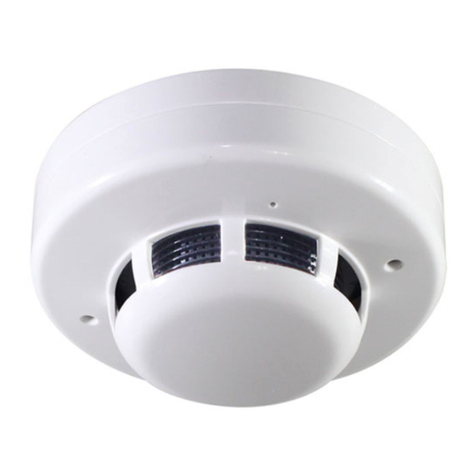
Lexing
Lexing LX928 Using instruction
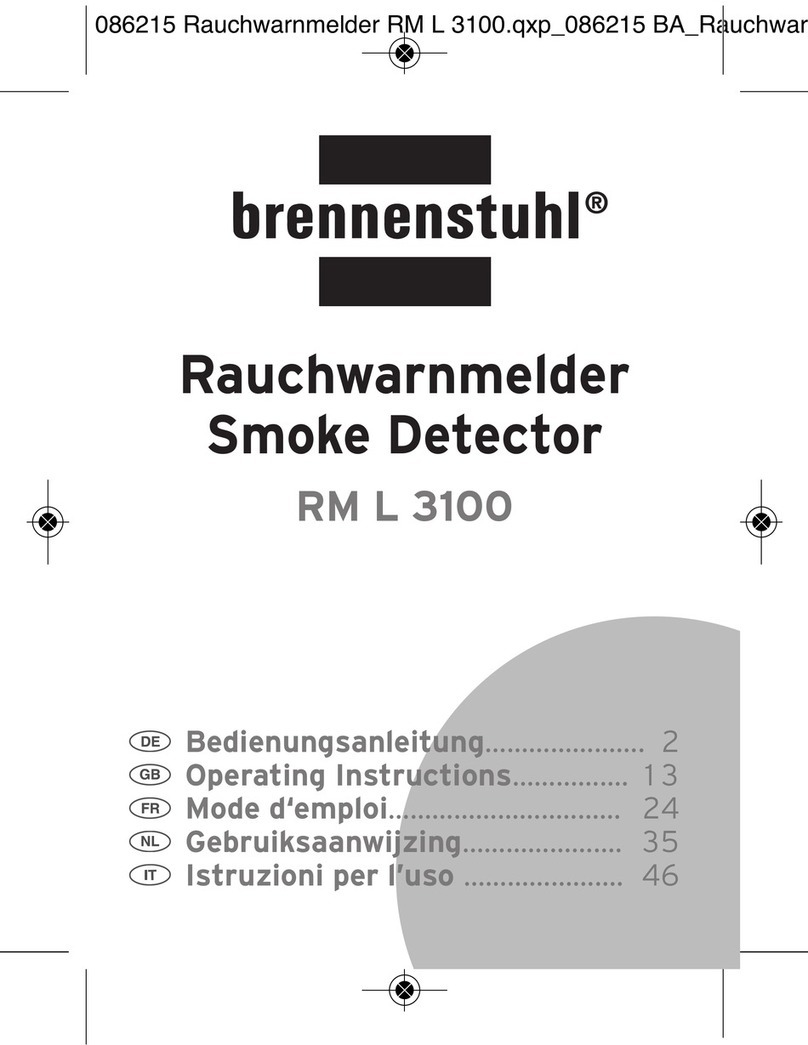
brennenstuhl
brennenstuhl RM L 3100 operating instructions
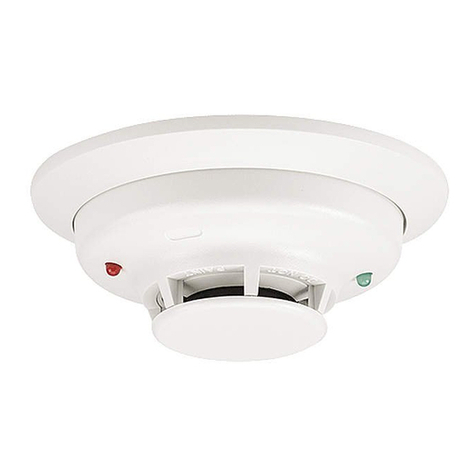
System Sensor
System Sensor 4WT-B Installation and maintenance instructions
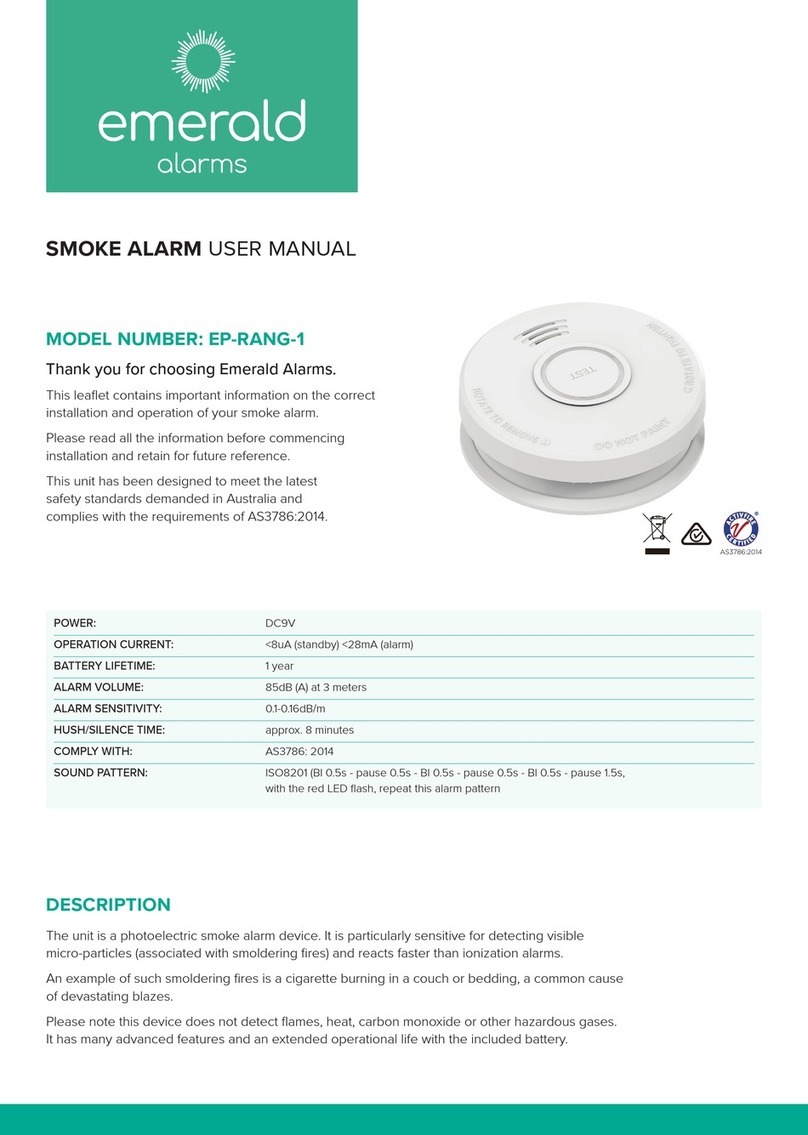
emerald alarms
emerald alarms EP-RANG-1 user manual
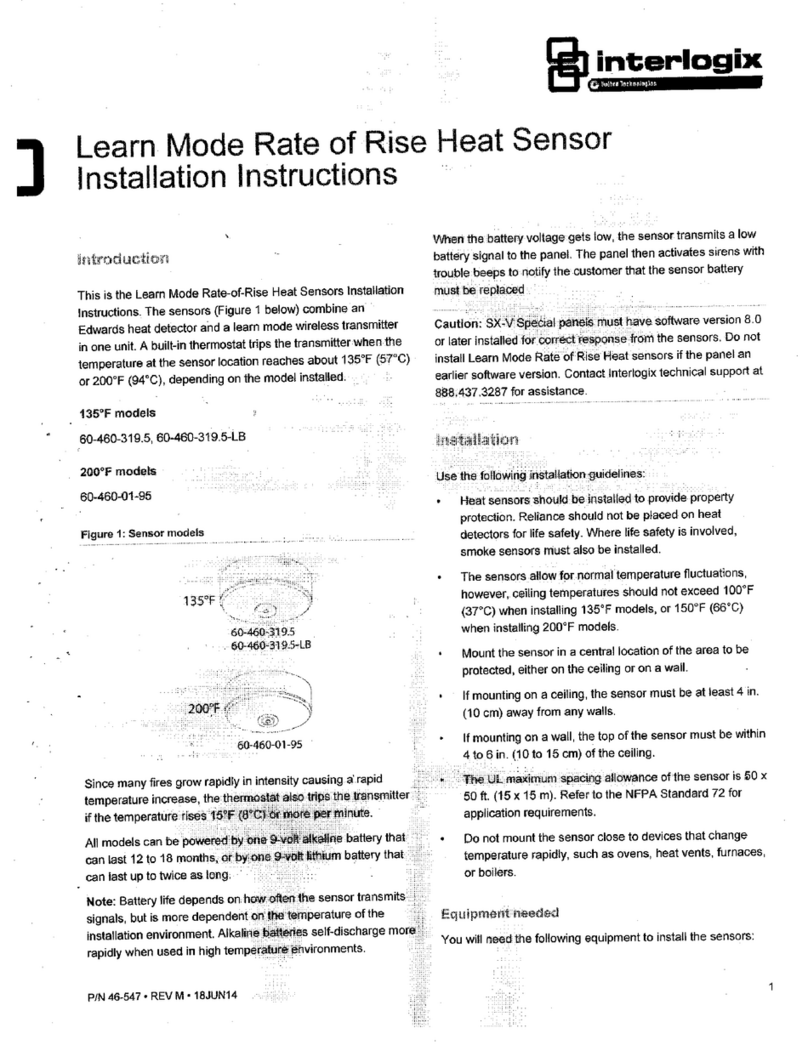
Interlogix
Interlogix 60-460-319.5 installation instructions
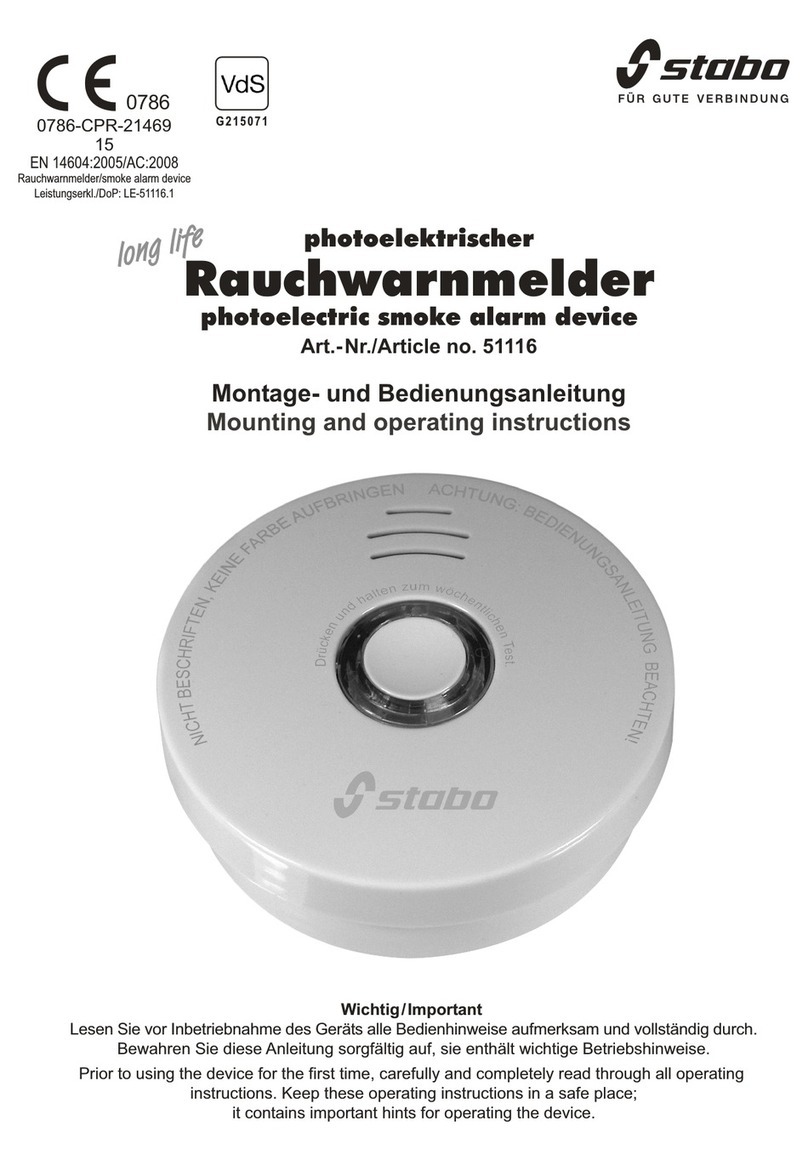
stabo
stabo 51116 Mounting and operating instructions

